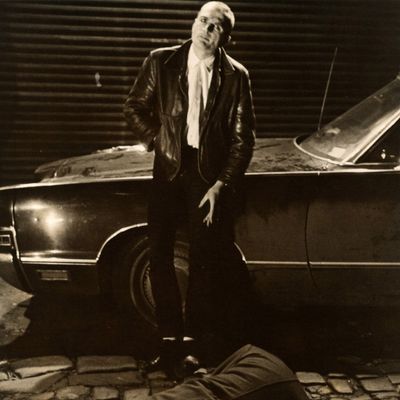
In a 1995 interview, director Kathryn Bigelow (of Zero Dark Thirty and The Hurt Locker fame) recalled filming The Set-Up ÔÇö her experimental short film that she ended up submitting as her MFA thesis with Columbia University. It also happened to be her first cinematic endeavor. ÔÇ£I started shooting at about 9pm and finished at 7am,ÔÇØ she said. ÔÇ£It was in an alley off White Street downtown, and it started to snow.ÔÇØ
In it, two men pummeled each other to a bloody pulp, accompanied by a voice-over of two philosophy professors providing dry commentary. ÔÇ£I knew exactly what I wanted,ÔÇØ said Bigelow. ÔÇ£But I didnÔÇÖt understand that you fake shots and fake hits and put sound effects in.ÔÇØ As a result, ÔÇ£these guys were getting bloodier and bloodier. They were in bed for two weeks after, I almost killed them.ÔÇØ With French structuralist theory among its influences, The Set-Up took a formal look at violenceÔÇÖs allure and its political connection to fascism; though Bigelow was still in grad school, sheÔÇÖd already refined her aesthetic and conceptual-art chops, having studied as a painter, gone to WhitneyÔÇÖs Independent Study Program, and worked with the likes of Richard Serra and Lawrence Weiner.
Maybe because the Academy AwardÔÇôwinning director downplays this student film ÔÇö which is also maybe why itÔÇÖs nowhere to be found online ÔÇö The Set-Up enjoys a somewhat mythical status in the eyes of cinephiles hoping to trace the directorÔÇÖs skillful deployment of violence back to its very earliest roots. (Critic Dan Kois even issued an online plea asking her to release the film: ÔÇ£We want to see it so bad,ÔÇØ he wrote.) It doesnÔÇÖt help that the director is notoriously press-shy, turning down profiles from major magazines.
Now, at MoMA this evening, BigelowÔÇÖs fans can view The Set-Up alongside the six other short films with which it was screened in 1978. The occasion: an evening restaging of a cinema series organized by Bigelow and filmmaker Michael Oblowitz, who ÔÇö as twenty-something denizens of New YorkÔÇÖs underground cultural scene ÔÇö were active in a group of grad students and professors whoÔÇÖd founded Semiotext(e), a radical New YorkÔÇôbased journal that imported French theory to the U.S. and sought to dissolve boundaries between high and low culture. In 1975, the group staged a conference and a special issue of the magazine, which they called ÔÇ£Schizo-Culture.ÔÇØ Uniting artists, writers, and No Wave bands, the event brought everyone from John Cage to William S. Burroughs into the mix.
Oblowitz remembers meeting Bigelow on their first day as students at Columbia University: ÔÇ£We were the only two students wearing black jeans, motorcycle boots, and leather jackets.ÔÇØ Collaborators henceforth, the two dubbed their film series Cine-Virus ÔÇö a name inspired by Burroughs, who at the time was comparing words and images to viruses that mutated and infected peopleÔÇÖs minds. Partially re-created tonight at MoMA in celebration of Semiotext(e)ÔÇÖs 40th anniversary (which also inspired an afternoon of performances and readings yesterday at P.S. 1), the two-hour-long program includes non-narrative flicks and experimental mash-ups, and ranges from a montage-driven music video for DevoÔÇÖs first single ÔÇ£MongoloidÔÇØ to video ÔÇ£cut-upsÔÇØ on which William S. Burroughs himself collaborated.
ItÔÇÖs pretty clear that, back then, reaching audiences nationwide wasnÔÇÖt first and foremost on anyoneÔÇÖs mind (even while Bigelow has said she was discovering that movies were more accessible than painting, her first chosen art form). ÔÇ£Cine-Virus was an epistemological break with syntax,ÔÇØ Oblowitz said. But even as some of those featured in the film series graduated to much higher-profile projects, the eveningÔÇÖs after effects seem to live on in their creative lives. Oblowitz himself later became one of MTVÔÇÖs first directors and three years ago filmed The Traveler, a horror movie starring Val Kilmer. Though heÔÇÖd learned to reach a large audience, he said: ÔÇ£I always have symbols, allusions, deconstructions, alienations that harken back to what was first floating through my mind in 1977 and 1978.ÔÇØ
ÔÇ£The legacy of Cine-Virus has not totally surprised me,ÔÇØ Oblowitz added. ÔÇ£It is a virus, after all.ÔÇØ


